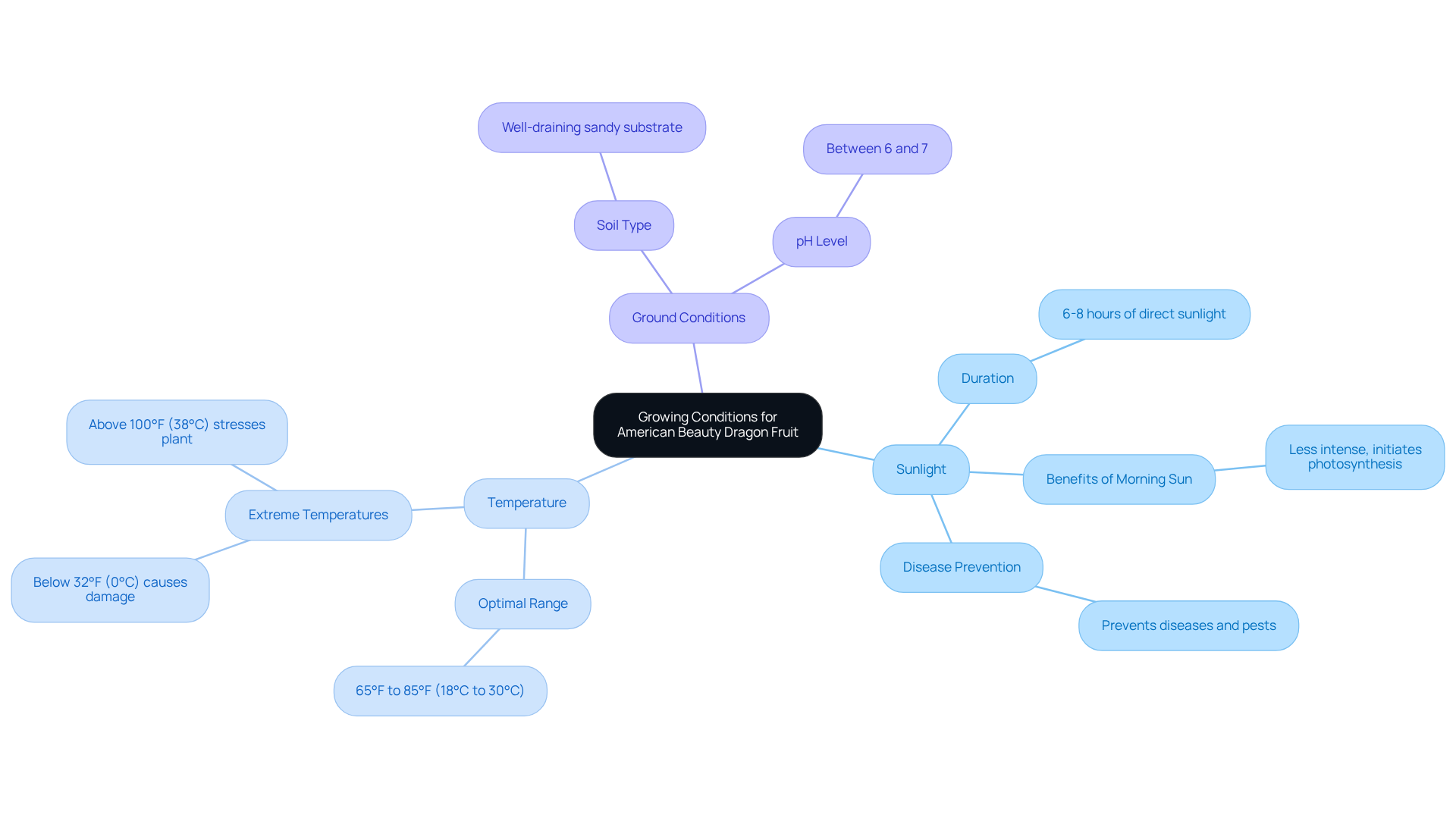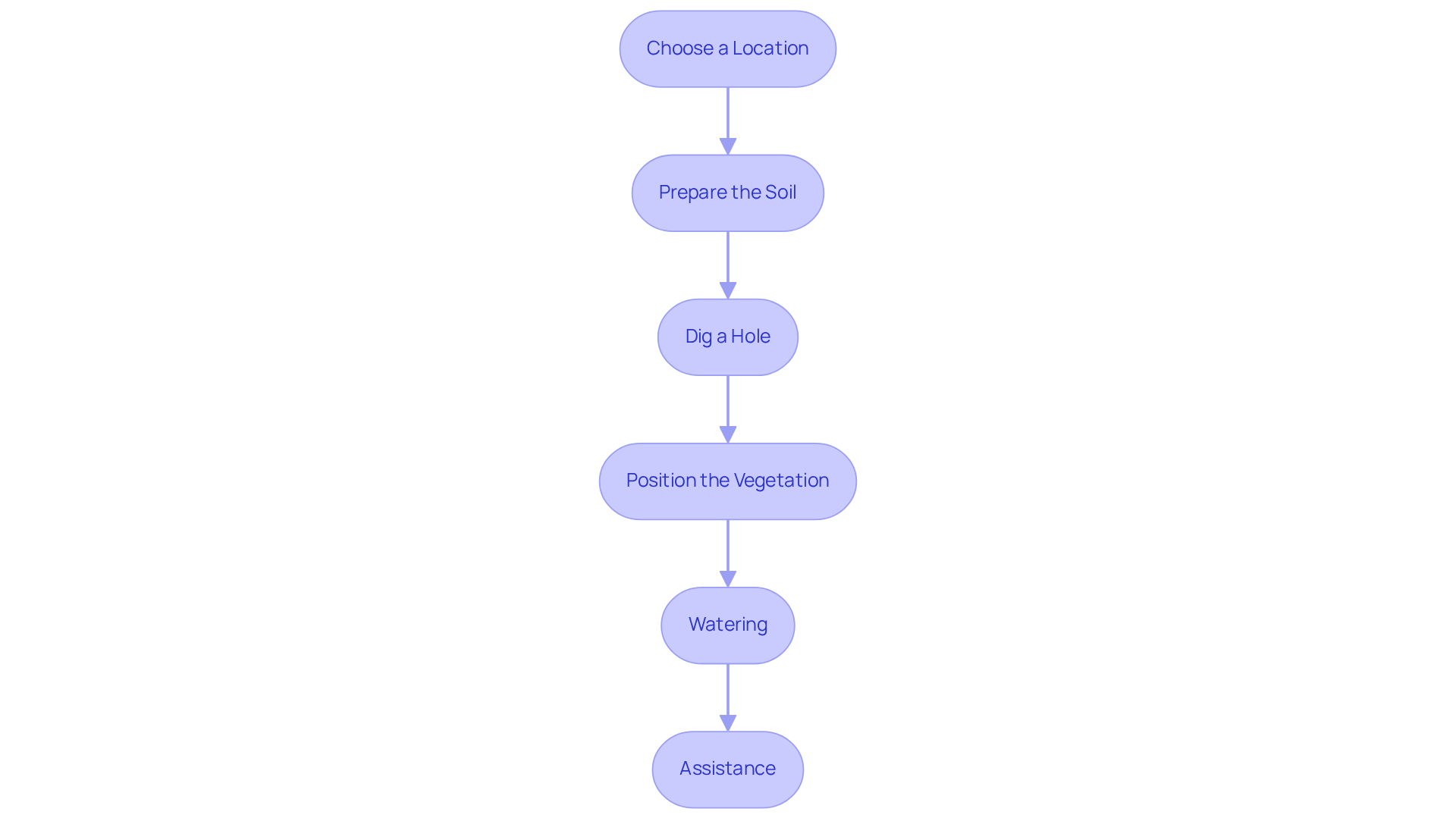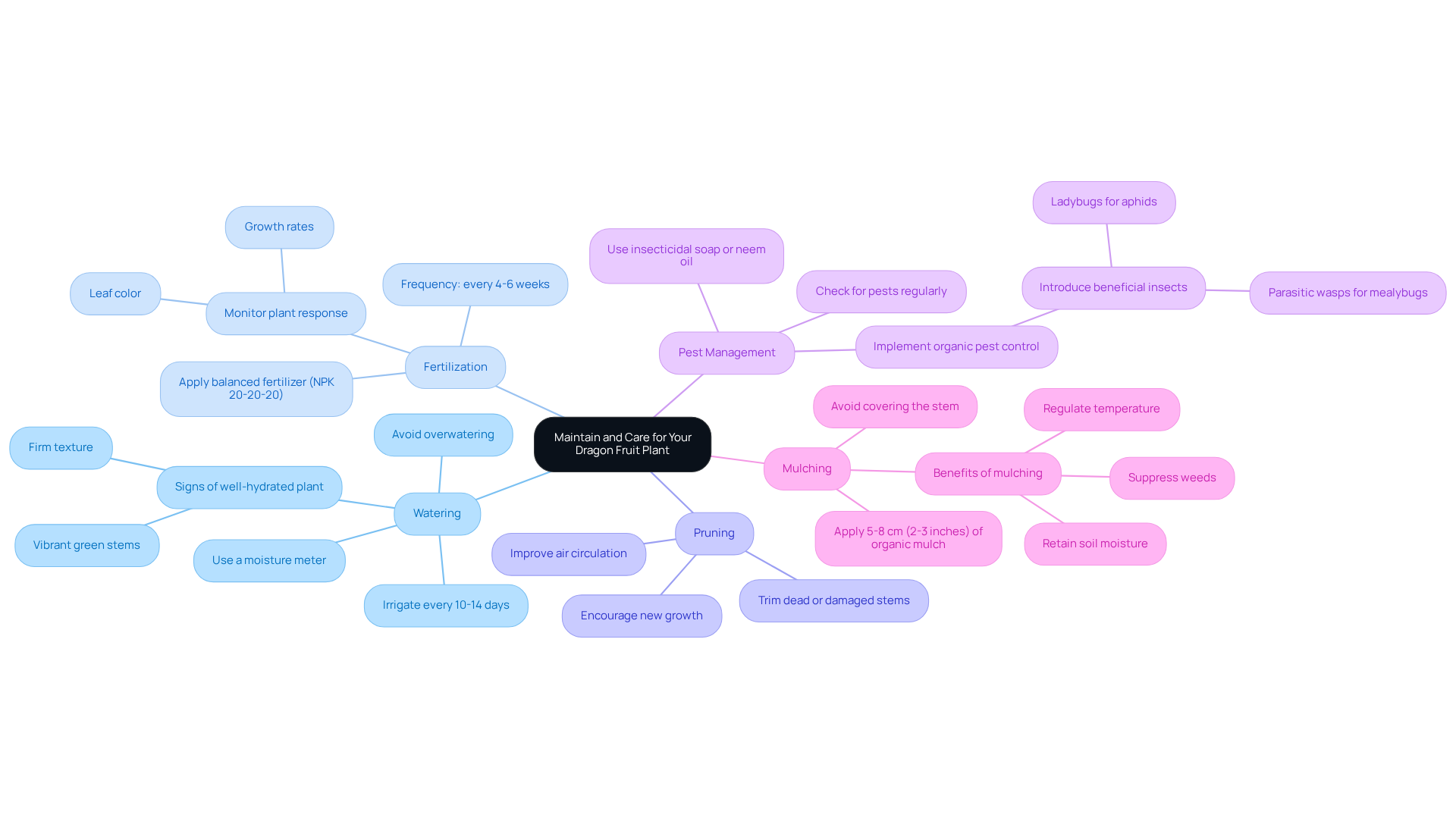Cultivating the vibrant American Beauty Dragon Fruit can be a rewarding endeavor, requiring a keen understanding of its unique growing needs. This guide outlines essential steps for success, from creating optimal growing conditions to effective maintenance practices.
However, with numerous variables at play—such as sunlight, soil, and temperature—what are the key factors that can influence a fruitful harvest?
Explore the intricacies of dragon fruit cultivation to learn how to navigate these challenges and ensure a bountiful yield.
Thinking about growing an American Beauty Dragon Fruit in your garden?
Explore American Beauty Dragon Fruit Tree for sale at Everglades Farm - shipped directly from Florida.
1. Understand Growing Conditions for American Beauty Dragon Fruit
To successfully cultivate the American Beauty Dragon Fruit, providing is crucial.
- Sunlight: The vegetation flourishes with at least 6-8 hours of direct sunlight each day, which is essential for efficient photosynthesis and strong fruit production. Morning sunlight is particularly beneficial, as it is less intense and helps initiate the photosynthesis process. Adequate sunlight also helps prevent diseases and pests that thrive in shaded, damp environments. Regular inspection of the facility during hot months can help catch and address sun damage early.
- Temperature: The optimal temperature range for development is between 65°F to 85°F (18°C to 30°C). Exposure to temperatures below 32°F (0°C) can cause significant damage to the plant, while prolonged exposure to temperatures above 100°F (38°C) can stress the plant, reducing fruit quality and yield. As noted by horticulturist Michael Schiffermuller, optimal vegetative growth occurs at temperatures between 27°C to 35°C.
- Ground: A well-draining, sandy substrate is essential, with a pH level between 6 and 7. A cactus mix or a combination of potting soil and perlite is highly effective for promoting healthy root development.
Space for American Beauty Dragon Fruit specimens is essential, as they can expand considerably, requiring sufficient area for development. Ideally, place it at least 15-25 feet away from structures and other vegetation to accommodate its sprawling nature.
By ensuring these conditions are met, you create a thriving environment that supports the healthy development and fruiting of your dragon fruit species.

2. Plant American Beauty Dragon Fruit: Step-by-Step Instructions
To successfully plant your American Beauty Dragon Fruit, follow these essential steps:
- Choose a Location: Select a sunny area with well-draining ground. Avoid heavy clay or waterlogged conditions, as these can hinder growth.
- Prepare the Soil: Enrich the soil by mixing in organic matter or compost. Ensure it is loose and well-aerated to promote healthy root development. The optimal growing temperatures for American Beauty Dragon Fruit plants range from 65°F to 80°F, so ensure that your planting location meets these conditions.
- Dig a Hole: Create a hole that is twice the size of the root ball of your dragon fruit specimen. This allows ample space for root expansion.
- Position the Vegetation: Place the vegetation in the hole, ensuring the top of the root ball is level with the ground surface. Fill the hole with earth and gently pat it down to eliminate air pockets.
- Watering: After planting, water the vegetation thoroughly. This helps settle the soil around the roots and ensures excess water drains away to .
- Assistance: For smaller vegetation, consider staking with a bamboo stick to provide necessary support as they grow. Additionally, offering a robust trellis is essential for aiding the development of dragon species, as they can grow large and heavy.
By following these guidelines, you will establish a solid foundation for cultivating American Beauty Dragon Fruit, creating an environment conducive to abundant growth. Gardening specialists emphasize that suitable ground preparation and planting methods are crucial for the success of dragon cultivation, ensuring that your plant thrives in its new setting. As noted by Michael Schiffermuller, "Providing proper care, including regular watering, fertilization, and protection from pests and diseases, can help promote healthy growth and fruit production.

3. Maintain and Care for Your Dragon Fruit Plant
To maintain and care for your American Beauty Dragon Fruit, adhere to the following guidelines:
Watering: Irrigate the vegetation every 10-14 days, ensuring the earth dries out between irrigations to prevent root rot, a frequent problem caused by excessive watering. Indicators of a well-hydrated organism include vibrant green stems and firm texture. Consider using a moisture meter to determine when the vegetation needs water, aiming for a reading that shows the soil is lightly moist but not wet.
Fertilization: Apply a balanced fertilizer with an NPK ratio of 20-20-20 every 4-6 weeks during the growing season (spring to fall). This promotes healthy development and fruit production. It's crucial to recognize that the ideal NPK ratio can change by development stage, so observing responses, such as leaf color and increase rates, can assist in optimizing fertilizer application. Healthy leaves should exhibit a vibrant green color.
Pruning: Regularly trim the vegetation to remove any dead or damaged stems. This encourages new growth and improves air circulation, thereby reducing the risk of pests and diseases.
Pest Management: Conduct routine checks for pests like mealybugs and aphids. If infestations arise, address them quickly with insecticidal soap or neem oil to safeguard your greenery's health. Additionally, consider implementing organic pest control strategies, such as introducing beneficial insects that prey on common pests, to maintain a healthy garden ecosystem. For example, ladybugs can help control aphid populations, while parasitic wasps can target mealybugs. These techniques not only safeguard your dragon fruit but also correspond with sustainable gardening practices that benefit other species, such as passion fruit vines and soursop trees.
Mulching: Apply a 5-8 cm (2-3 inches) thick layer of organic mulch around the base of the specimen, avoiding coverage of the stem to prevent rot. This helps retain moisture in the ground, regulate temperature, and suppress weeds, contributing to a healthier growing environment.
By following these care practices, you will create an optimal environment for your dragon fruit plant, leading to robust growth and increased fruit production.

4. Troubleshoot Common Issues in Growing Dragon Fruit
Here are some common issues you may encounter while growing American Beauty Dragon Fruit, along with effective solutions to address them:
- Overwatering: Symptoms include yellowing stems and mushy roots. Allow the soil to dry out completely before watering again, ideally when the top 2-3 inches feel dry. In cases of root rot, remove the affected roots and repot in fresh, well-draining soil.
- Inadequate Sunlight: If the plant appears leggy or is not producing fruit, it may not be receiving sufficient light. American beauty dragon fruit thrives best when it receives 6-8 hours of direct sunlight daily. As gardening expert Sarah Lee notes, while these plants can tolerate some shade, they will not yield as much fruit as they would in full sunlight. Consider moving the plant to a sunnier spot or supplementing with grow lights if indoors.
- Pest Infestations: Watch for such as mealybugs or spider mites. Address any infestations promptly using insecticidal soap or neem oil, and ensure proper air circulation around the plant to prevent future outbreaks. Additionally, monitor leaves for orange rust dots to catch disease issues early.
- Nutrient Deficiencies: Yellowing leaves may indicate a lack of nutrients. Fertilize with a balanced fertilizer every 6-8 weeks during the growing season to replenish soil nutrients, and reduce fertilization during dormancy to avoid over-fertilizing.
- Temperature Stress: If the plant shows signs of wilting or browning, it may be exposed to extreme temperatures. Protect it from frost and excessive heat by relocating it to a more suitable environment or providing shade during the hottest parts of the day.
By recognizing these issues early and applying the suggested solutions, you can maintain a healthy and productive dragon fruit plant.
Conclusion
Successfully cultivating the American Beauty Dragon Fruit necessitates a comprehensive understanding of its unique needs and optimal growing conditions. By prioritizing factors such as sunlight, temperature, and soil composition, gardeners can create an environment that fosters healthy growth and abundant fruit production.
Key insights from the article underscore the significance of proper planting techniques, regular maintenance, and addressing common issues. From selecting the right location and enriching the soil to establishing a consistent watering and fertilization schedule, each step is crucial in ensuring the plant thrives. Furthermore, vigilance regarding pests and environmental stressors can profoundly affect the overall health and yield of the dragon fruit.
Ultimately, cultivating the American Beauty Dragon Fruit transcends mere adherence to instructions; it represents an engaging journey that cultivates a deeper connection with nature. By implementing the best practices outlined in this guide, gardeners can not only reap the rewards of their labor but also contribute to sustainable gardening efforts. Embrace the challenge and find joy in the process of growing this extraordinary fruit, securing a fruitful harvest for years to come.
Cultivate Your Own American Beauty Dragon Fruit Today!
Join Everglades Farm and transform your garden into a tropical paradise with our premium fruit trees.
Frequently Asked Questions
What are the ideal sunlight conditions for growing American Beauty Dragon Fruit?
American Beauty Dragon Fruit requires at least 6-8 hours of direct sunlight each day for efficient photosynthesis and strong fruit production. Morning sunlight is particularly beneficial.
What temperature range is optimal for the growth of American Beauty Dragon Fruit?
The optimal temperature range for the development of American Beauty Dragon Fruit is between 65°F to 85°F (18°C to 30°C). Temperatures below 32°F (0°C) can damage the plant, while prolonged exposure to temperatures above 100°F (38°C) can stress the plant and reduce fruit quality.
What type of soil is best for American Beauty Dragon Fruit?
A well-draining, sandy substrate with a pH level between 6 and 7 is essential for American Beauty Dragon Fruit. A cactus mix or a combination of potting soil and perlite is effective for promoting healthy root development.
How much space should be allocated for growing American Beauty Dragon Fruit?
American Beauty Dragon Fruit specimens require sufficient space to expand, ideally being placed at least 15-25 feet away from structures and other vegetation to accommodate their sprawling nature.
Why is it important to provide optimal growing conditions for American Beauty Dragon Fruit?
Providing optimal growing conditions is crucial for creating a thriving environment that supports the healthy development and fruiting of the American Beauty Dragon Fruit species.




0 comments